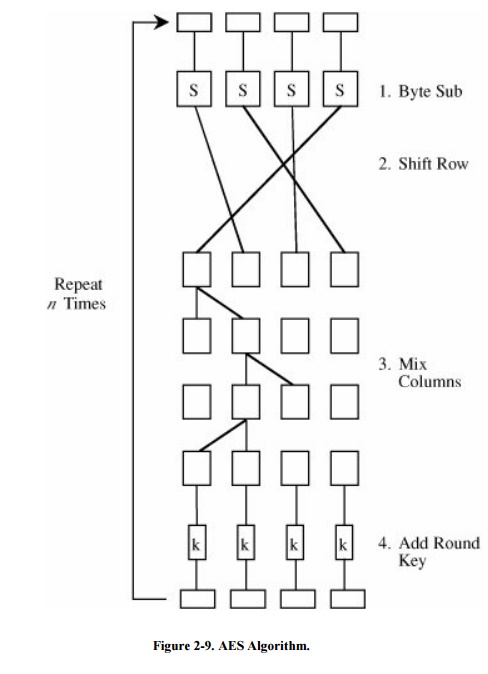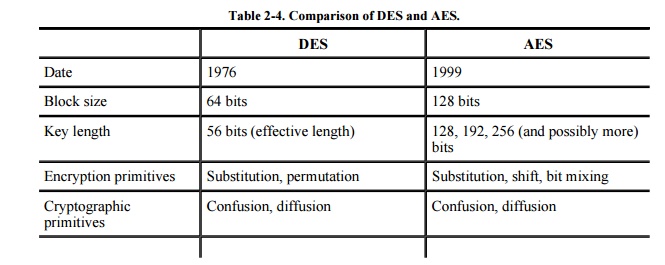Chapter: Security in Computing : Elementary Cryptography
The AES Encryption Algorithm
The AES Encryption Algorithm
The AES is likely to be the
commercial-grade symmetric algorithm of choice for years, if not decades. Let
us look at it more closely.
The AES Contest
In January 1997, NIST called
for cryptographers to develop a new encryption system. As with the call for
candidates from which DES was selected, NIST made several important
restrictions. The algorithms had to be
unclassified
publicly disclosed
available royalty-free for use worldwide
symmetric block cipher algorithms, for blocks
of 128 bits
usable with key sizes of 128, 192, and 256 bits
In August 1998, fifteen
algorithms were chosen from among those submitted; in August 1999, the field of
candidates was narrowed to five finalists. The five then underwent extensive
public and private scrutiny. The final selection was made on the basis not only
of security but also of cost or efficiency of operation and ease of
implementation in software. The winning algorithm, submitted by two Dutch
cryptographers, was Rijndael (pronounced RINE dahl or, to hear the inventors
pronounce it themselves, visit rijndael.com/audio/rijndael_pronunciation.wav); the algorithm's name is derived from the creators'
names, Vincent Rijmen and Joan Daemen. (NIST described the four not chosen as also having
adequate security for the AESno cryptographic flaws were identified in any of the
five. Thus, the selection was based on efficiency and implementation
characteristics.)
The AES was adopted for use
by the U.S. government in December 2001 and became Federal Information
Processing Standard 197 [NIS01].
Overview of Rijndael
Rijndael is a fast algorithm that can be implemented easily on simple
processors. Although it has a strong mathematical foundation, it primarily uses substitution;
transposition; and the shift, exclusive OR, and addition operations. Like DES,
AES uses repeat cycles. There are 10, 12, or 14 cycles for keys of 128, 192,
and 256 bits, respectively. In Rijndael, the cycles are called "rounds."
Each cycle consists of four
steps.
Byte substitution: This step uses a
substitution box structure similar to the DES, substituting each byte of a
128-bit block according to a substitution table. This is a straight diffusion operation.
Shift row: A transposition step. For 128- and
192-bit block sizes, row n is shifted left circular (n - 1) bytes; for 256-bit
blocks, row 2 is shifted 1 byte and rows 3 and 4 are shifted 3 and 4 bytes,
respectively. This is a straight confusion operation.
Mix column: This step involves shifting left
and exclusive-ORing bits with themselves. These operations provide both
confusion and diffusion.
Add subkey: Here, a portion of the key unique
to this cycle is exclusive-ORed with the cycle result. This operation provides
confusion and incorporates the key.
These four steps are described in more detail
in Chapter 12. Note that the steps
perform both diffusion and confusion on the input data. Bits from the key are
combined with intermediate result bits frequently, so key bits are also well
diffused throughout the result. Furthermore, these four steps are extremely
fast. The AES algorithm is depicted in Figure 2-9.

Strength of the Algorithm
The Rijndael algorithm is
quite new, so there are few reports of extensive experience with its use.
However, between its submission as a candidate for AES in 1997 and its
selection in 2001, it underwent extensive cryptanalysis by both government and
independent cryptographers. Its Dutch inventors have no relationship to the NSA
or any other part of the U.S. government, so there is no suspicion that the
government somehow weakened the algorithm or added a trapdoor. Although the
steps of a cycle are simple to describe and seem to be rather random
transformations of bits, in fact (as described in some detail in Chapter 12), these transformations have a sound
mathematical origin.
Comparison of DES and AES


When Rijndael's predecessor,
DES, was adopted, two questions quickly arose:
How strong is it, and in particular, are there
any backdoors?
How long would it be until the encrypted code
could be routinely cracked?
With nearly 30 years of use,
suspicions of weakness (intentional or not) and backdoors have pretty much been
quashed. Not only have analysts failed to find any significant flaws, but in
fact research has shown that seemingly insignificant changes weaken the
strength of the algorithmthat is, the algorithm is the best it can be. The
second question, about how long DES would last, went unanswered for a long time
but then was answered very quickly by two experiments in which DES was cracked
in days. Thus, after 20 years, the power of individual specialized processors
and of massive parallel searches finally overtook the fixed DES key size.
We must ask the same
questions about AES: Does it have flaws, and for how long will it remain sound?
We cannot address the question of flaws yet, other than to say that teams of
cryptanalysts pored over the design of Rijndael during the two-year review
period without finding any problems.
The longevity question is
more difficult, but also more optimistic, to answer for AES than for DES. The
AES algorithm as defined can use 128-, 192-, or 256-bit keys. This
characteristic means that AES starts with a key more than double the size of a
DES key and can extend to double it yet again. (Remember that doubling the key
length squares the number of possible keys that need to be tested in attempts
to break the encryption.) But because there is an evident underlying structure,
it is also possible to use the same general approach on a slightly different
underlying problem and accommodate keys of even larger size. (Even a key size
of 256 is prodigious, however.) Thus, unlike DES, AES can move to a longer key
length any time technology seems to allow an analyst to overtake the current
key size.
Moreover, the number of
cycles can be extended in a natural way. With DES the algorithm was defined for
precisely 16 cycles; to extend that number would require substantial
redefinition of the algorithm. The internal structure of AES has no a priori
limitation on the number of cycles. If a cryptanalyst ever concluded that 10 or
12 or 14 rounds were too low, the only change needed to improve the algorithm
would be to change the limit on a repeat loop.
A mark of confidence is that
the U.S. government has approved AES for protecting Secret and Top Secret
classified documents. This is the first time the United States has ever
approved use of a commercial algorithm derived outside the government (and
furthermore outside the United States) to encrypt classified data.
However, we cannot rest on our laurels. It is
impossible to predict now what limitations cryptanalysts might identify in the
future. At present, AES seems to be a significant improvement over DES, and it
can be improved in a natural way if necessary.
Related Topics